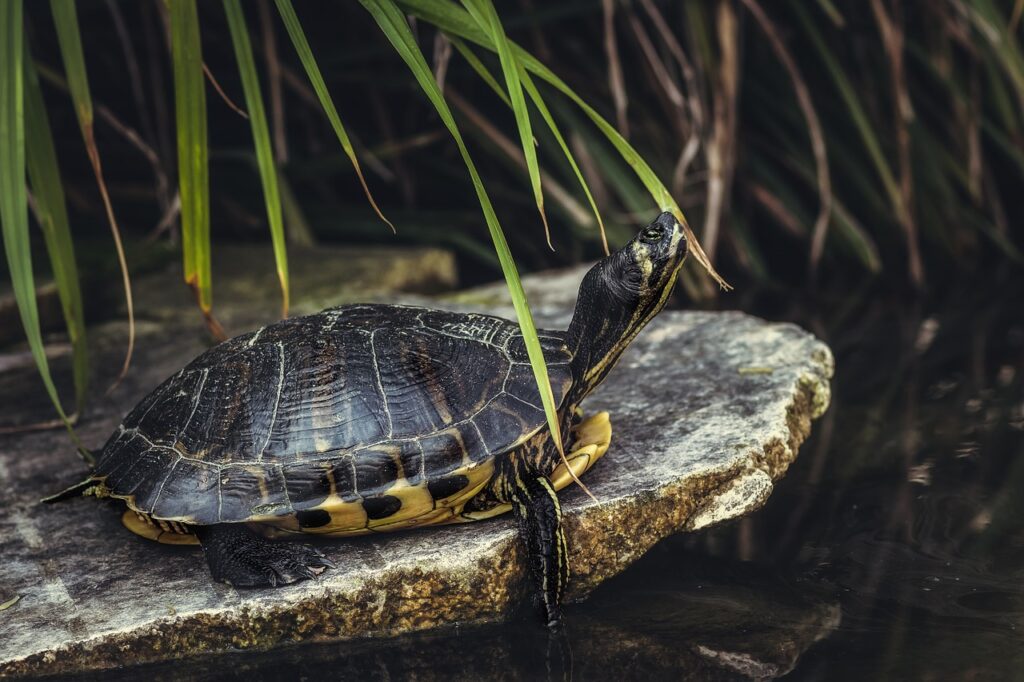If you’ve ever wondered what exactly an alligator snapping turtle is, you’re in for a wild surprise. This unique creature, known for its prehistoric appearance and powerful jaws, is like something straight out of a dinosaur movie. With its massive spiked shell, beady eyes, and long, worm-like tongue, the alligator snapping turtle is a captivating species that leaves people amazed and intrigued. But what makes this remarkable reptile so special? Let’s take a closer look at what exactly an alligator snapping turtle is and discover some fascinating facts about this ancient creature.

Physical Description
Size and Weight
The alligator snapping turtle is one of the largest freshwater turtles in the world. As an adult, it can reach impressive sizes, with males typically measuring between 26 to 32 inches in length and weighing around 175 pounds. Females are slightly smaller, averaging around 20 to 26 inches in length and weighing approximately 50 to 110 pounds.
Shell
The shell of an alligator snapping turtle is characterized by its rough and knobby appearance. It is oval-shaped and can range in color from dark brown to black. Unlike other turtles, the shell of the alligator snapping turtle possesses three prominent ridges that run down the length of its carapace, resembling the raised plates on an alligator’s back.
Skin
The skin of the alligator snapping turtle is rough and covered in scaly, bumpy plates. These plates not only provide an extra layer of protection but also aid in camouflage, allowing the turtle to blend in with its surrounding environment. The coloration of the skin varies from dark brown to black, providing excellent camouflage within the murky waters it inhabits.
Head and Beak
The most distinguishing feature of an alligator snapping turtle is its massive head. It has a large, muscular head with a pointed snout and a powerful hooked beak, resembling that of an alligator. This beak is used for capturing prey and can deliver a painful bite. The head is covered with a rough, pebbly skin, providing additional protection.
Tail
The alligator snapping turtle has a long, thick tail, perfect for propelling itself through the water. Unlike some other turtle species, its tail is not prehensile but plays an essential role in swimming and maintaining balance. The tail also possesses a row of large scales on the upper side, adding to its distinctive appearance.
Habitat and Distribution
Freshwater Habitats
Alligator snapping turtles are primarily found in freshwater habitats, such as rivers, lakes, and swamps. They prefer slow-moving bodies of water with abundant vegetation and submerged logs, which provide hiding places and basking spots. These turtles are well-adapted to living in aquatic environments and rarely venture onto land.
Geographical Range
The alligator snapping turtle is native to the southeastern United States, primarily inhabiting the states of Florida, Georgia, Alabama, Mississippi, Louisiana, Arkansas, Oklahoma, and Texas. Within this range, they are often found in the drainage basins of major rivers, such as the Mississippi, Tennessee, and Suwannee River.
Preferred Locations
Within their geographical range, alligator snapping turtles exhibit a preference for certain types of locations. They are commonly found in areas with abundant aquatic vegetation, submerged logs, and a diverse range of prey species. Additionally, they tend to select habitats with favorable water quality and temperatures that suit their specific needs.
Population Status
Unfortunately, the population of alligator snapping turtles has been declining in recent years. Due to overhunting, habitat loss, and pollution, these turtles are now considered a species of concern. Efforts are being made to better understand their population dynamics and implement conservation measures to protect their habitats and facilitate population recovery.
Feeding Habits
Carnivorous Diet
Alligator snapping turtles are apex predators and have a primarily carnivorous diet. They are opportunistic feeders, consuming a wide range of prey, including fish, amphibians, snakes, birds, small mammals, and even other turtles. With their powerful jaws and sharp beaks, they are capable of crushing the shells of their prey, making them a formidable predator.
Baiting Technique
One fascinating feeding behavior of the alligator snapping turtle is its use of a baiting technique to lure prey. They possess a worm-shaped appendage on their tongue that they use to attract fish and other small animals. By wiggling this appendage, they mimic the movement of a worm, drawing in unsuspecting prey that become an easy meal.
Ambush Predators
Alligator snapping turtles are ambush predators, lying motionless on the bottom of the water body, partially hidden by vegetation or submerged logs. They patiently wait for an opportune moment to strike, relying on their excellent camouflage and their ability to remain perfectly still for extended periods. Once they detect prey within striking distance, they launch a lightning-fast attack with their powerful jaws, capturing their prey in a split second.
Diet Variation
While alligator snapping turtles primarily rely on animal matter for sustenance, they have been known to consume plant material as well. On occasion, they may feed on aquatic vegetation, algae, and fallen fruits. However, the majority of their diet consists of animal prey, as they require the protein and nutrients found in these sources to thrive.
Reproduction and Life Cycle
Sexual Dimorphism
It can be challenging to determine the sex of alligator snapping turtles visually, as they do not exhibit any significant physical differences until they reach maturity. However, once mature, males typically have longer and thicker tails than females. Additionally, males tend to have more prominent and pronounced features on their shells and heads.
Mating Behavior
Alligator snapping turtles engage in elaborate courtship behaviors during the mating season, which typically occurs in the spring. Males use various techniques to attract females, including head bobbing, neck stretching, and releasing pheromones to signal their readiness to mate. Once a female is enticed, she will allow the male to approach and mate.
Egg Laying and Incubation
After mating, females will seek out suitable nesting sites to lay their eggs, typically on sandy or gravelly riverbanks. They dig a nest cavity with their hind legs, where they will deposit a clutch of eggs. Each clutch can contain anywhere from 10 to 50 eggs, depending on the female’s size and reproductive health. Once the eggs are laid, the female will cover them with soil and return to the water.
Hatching and Growth
The incubation period for alligator snapping turtles can range from 100 to 140 days, depending on environmental conditions. Once the eggs hatch, the hatchlings will make their way to the water, often using the light of the moon as a guide. These young turtles are vulnerable to predation during this stage, and only a small percentage will survive to adulthood. As they grow, the turtles will shed their scutes, or outer shell plates, multiple times, allowing their shells to expand with their increasing size.

Behavior and Adaptations
Nocturnal Resting Behavior
Alligator snapping turtles are predominantly nocturnal, meaning they are most active during the night. During the day, they often rest on the bottom of their aquatic habitat, partially buried in sediment or concealed under submerged vegetation. This resting behavior not only allows them to conserve energy but also provides protection from potential predators.
Camouflage
Camouflage is a vital adaptation for alligator snapping turtles. Their rough, pebbly skin and dark coloration blend seamlessly with the surrounding environment of muddy waters and vegetation-covered riverbanks. This natural camouflage helps them remain undetected by both prey and predators, increasing their chances of survival.
Defensive Tactics
When threatened or cornered, alligator snapping turtles have several defensive tactics to protect themselves from harm. One of their primary defenses is their ability to snap their powerful jaws shut with incredible force, which can act as a powerful deterrent to potential predators. Additionally, they can emit a hissing sound and lunge aggressively at perceived threats.
Longevity
Alligator snapping turtles are known for their impressive longevity. With proper care and protection from threats, these turtles can live for several decades in the wild. Some individuals have been reported to live well over 100 years, making them one of the longest-lived reptiles in the world.
Conservation and Threats
Habitat Loss
One of the significant threats facing alligator snapping turtles is the loss of suitable habitat. As wetlands are drained for human development or converted for agriculture, the turtles lose their critical freshwater habitats. Destruction of nesting sites and pollution of water bodies also contribute to habitat degradation, further impacting their populations.
Illegal Pet Trade
Alligator snapping turtles are highly sought after in the illegal pet trade due to their unique appearance. This illegal trade disrupts wild populations as turtles are illegally captured and sold as pets, often leading to unsustainable rates of harvesting. The illegal pet trade poses a significant threat to the long-term survival of this species in the wild.
Overhunting
Historically, alligator snapping turtles were heavily hunted for their meat and shells, leading to significant population declines. While they are now protected by legislation, illegal hunting still poses a threat to their populations, particularly in regions where regulations are not adequately enforced.
Conservation Efforts
Conservation efforts are underway to protect the alligator snapping turtle and mitigate the threats it faces. These efforts include habitat preservation, the establishment of protected areas and sanctuaries, public awareness campaigns, and the enforcement of legislation to discourage illegal hunting and trading. Conservationists are also conducting research to gain a better understanding of the species and its population dynamics to inform conservation strategies.

Relationship with Humans
Traditional Folklore
Alligator snapping turtles hold significant cultural importance in certain regions. In folklore and mythology, these turtles are often seen as symbols of patience, wisdom, and endurance. They are sometimes portrayed as powerful and ancient creatures that possess supernatural qualities.
Human Interaction
Given their formidable appearance and natural aggression, it is advisable for humans to be cautious around alligator snapping turtles. Interaction with wild individuals should be avoided, as they can deliver painful bites that can cause severe injury. It is best to appreciate these creatures from a safe distance and respect their natural behavior and habitats.
Keeping as Pets
While alligator snapping turtles may be captivating, they are not suitable pets for the average person. Their large size, specific habitat requirements, and potential for aggression make them challenging to care for properly. Additionally, their capture and sale as pets contribute to the decline of wild populations. It is best to admire these turtles in their natural habitat or visit reputable zoological facilities that can properly care for them.
Legislation and Legal Protection
Recognizing the need to protect alligator snapping turtles, various laws and regulations have been put in place. Many states within their range have banned their capture and possession, promoting their conservation. Additionally, their listing as a threatened or protected species under state and federal laws prohibits their hunting and trade, helping to safeguard their populations.
Similar Species
Common Snapping Turtle
The alligator snapping turtle is often confused with the common snapping turtle (Chelydra serpentina). While both species share similarities in their appearance and behavior, there are distinct differences. The alligator snapping turtle is larger, has three prominent ridges on its shell, and possesses a hooked beak. In contrast, the common snapping turtle has a smoother shell, lacks the prominent ridges, and has a straighter beak.
Snapping Turtle vs. Alligator Snapping Turtle
The alligator snapping turtle and the common snapping turtle can be easily distinguished by their size, shell characteristics, and beak shape. The alligator snapping turtle is significantly larger, has three ridges on its shell, and a hooked beak. In contrast, the common snapping turtle is smaller, has a smoother shell, lacks prominent ridges, and possesses a straight beak.

Research and Study
Field Studies
Field studies play a crucial role in understanding the biology, behavior, and population dynamics of alligator snapping turtles. Researchers conduct surveys, capture and mark individuals for identification, and study their habitat preferences and movements. These studies provide valuable insights into the conservation needs of the species and contribute to the development of effective management strategies.
Captivity Studies
Alligator snapping turtles are often kept in captivity in zoological facilities and research institutions. These captive populations provide opportunities for behavioral and physiological studies, allowing researchers to learn more about their reproductive biology, growth rates, and overall health. Understanding these aspects helps inform conservation efforts and captive breeding programs aimed at aiding population recovery.
Scientific Contributions
Scientists studying alligator snapping turtles have made significant contributions to our understanding of this species. Their research has shed light on various aspects of their biology, behavior, and ecological role. These scientific contributions have helped inform conservation efforts, influence legislation, and raise public awareness about the importance of protecting these incredible reptiles.
Conclusion
The alligator snapping turtle is a fascinating and unique inhabitant of freshwater habitats in the southeastern United States. With its impressive size, formidable appearance, and incredible adaptations, it commands attention and respect. However, this iconic turtle is facing numerous threats, including habitat loss, illegal pet trade, and overhunting. Conservation efforts are essential to protect these turtles and ensure their long-term survival. By understanding their physical description, habitat preferences, feeding habits, and behavioral adaptations, we can appreciate the importance of preserving these majestic creatures for future generations.

